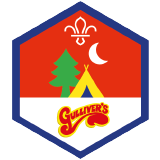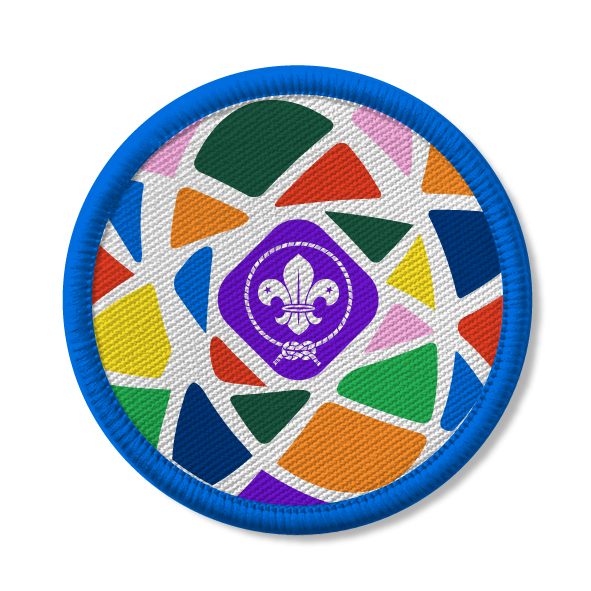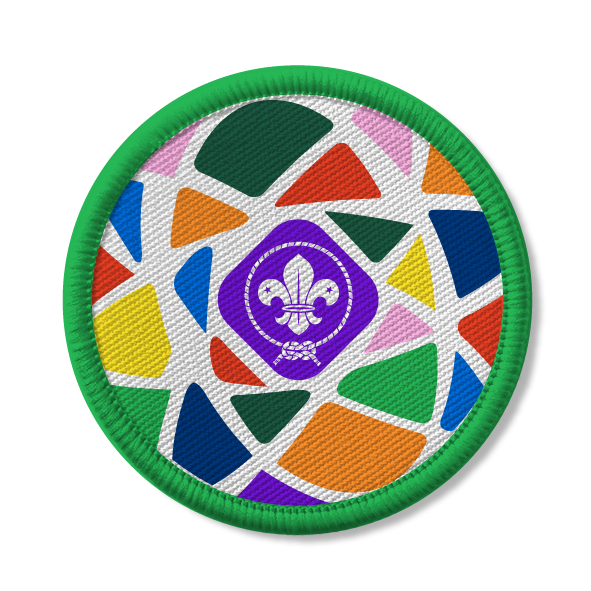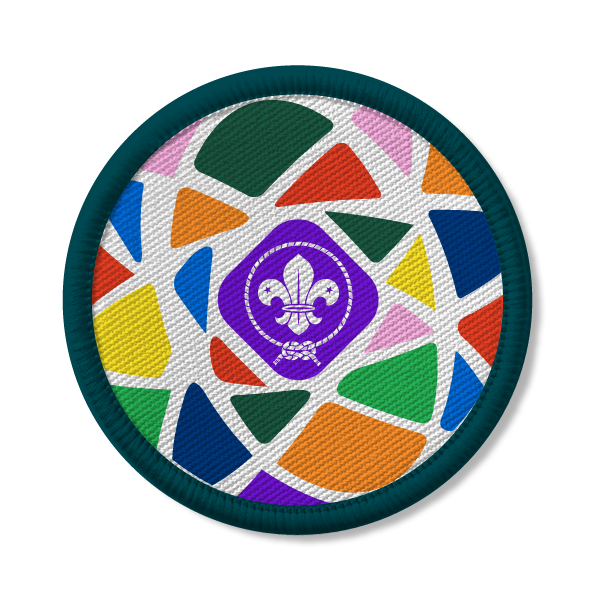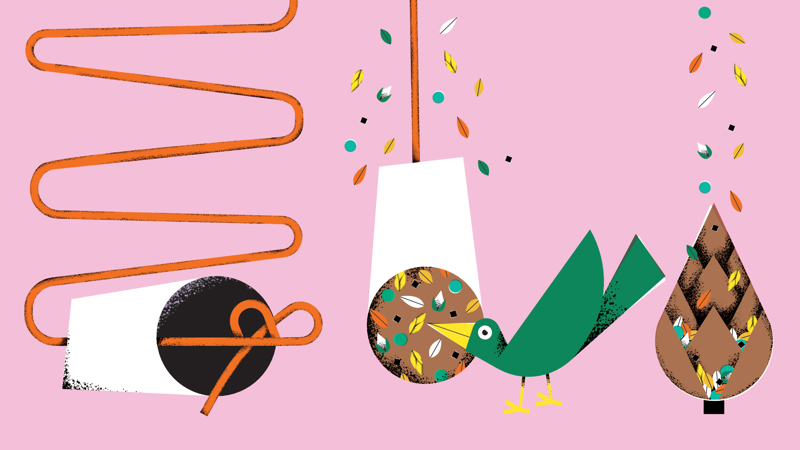
Feed the birds
You’ll need
- Mixing bowls
- Wooden spoons
- String
- Spoons
- Pine cones or yoghurt pots
- Nail or screwdriver (optional)
- Scissors (optional)
- Lard, suet or coconut oil
- Dried fruit
- Grated cheese
- Bird seed
- Tablecloths or newspaper
- Sticks (optional)
Before you begin
- This activity works best in autumn or winter, as that’s when birds need food the most. The colder weather also helps stop the bird feeders melting. If you’re making these in spring or summer, you could store them in the fridge until the birds need them.
- It’s up to you whether you use pine cones as bases, yoghurt pots as moulds, or apples as bird feeders. If you’re using the yoghurt pots, you’ll need a nail or screwdriver and some scissors. We’ve included instructions for all of the methods so you can choose what works for you.
- If you’re using pine cones, put them on a radiator or a sunny windowsill for a few hours to make sure they’re fully open.
- Cover tables with wipe clean tablecloths or newspaper, and set out the ingredients and equipment. You’ll need about one part fat (lard, suet, or coconut oil) to two parts of the other ingredients. It’s best to make sure that the fat is at room temperature.
- You’ll need to allow time for the bird feeders to set – they’ll probably need at least an hour in the fridge.
Chat about feathered friends
- Everyone should take it in turns to share what they know about birds. How many different birds can everyone name? Can they see or hear any? Who can do the best bird impression?
- There are lots of resources available to help everyone identify birds. This RSPB spotter sheet gets you started with some common birds – you could also use their online bird identifier or find out how to identify birds by their song.
Chat about feathered friends
- Explain that, as well as being beautiful to see and hear, birds are an important part of our ecosystems (where plants, animals, the weather, and the landscape work together to form a bubble of life).
- For example, some birds eat pests like aphids. Birds also spread seeds that grow into new plants when they eat fruit and poo out the seeds.
- Explain that some species of birds are struggling – we know this because there are fewer of them than there used to be. Some of the birds that are struggling are found in parks and gardens, for example, house sparrows and starlings.
- The RSPB have red, amber, and green lists of birds. These lists tell people which species need urgent action.
- Everyone should think about what they could do to help birds in their local area.
In colder weather, birds use a lot of energy to stay warm – especially if they’re small. There’s also less food for birds in winter, especially when humans’ actions, such as building houses and polluting areas, limit their food sources. Creating bird feeders with high-energy foods is a great way to help.
Mix it up
- Everyone should split into small groups, and go to a table with ingredients and equipment. You may need to remind everyone that although some of this food is the same as people may eat, they shouldn’t put anything in or near their mouths.
- Everyone should add the room temperature fat to the bowl, and squash it with the wooden spoon. Everyone can have a turn at squishing it – there’s no such thing as too much squishing in this activity. If you’re using coconut oil, it probably won’t take much squishing for it to be ready. If you’re using lard, it’s best to cut it into cubes before you put it into the bowl.
- Each group should add the other ingredients a bit at a time and stir them into the softened fat – it’s up to them whether they use a spoon or get stuck in with their hands. Everyone should have a turn at adding ingredients or stirring the mixture, until all of the ingredients and fat are nicely mixed together.
- Remember, you’ll need about one part fat to two parts other ingredients, for example, one cup of fat and two cups of seeds and dried fruit.
Option 1: craft the cone
- Everyone should tie a piece of string around the top row of a pine cone’s scales so the cone can hang up.
- Everyone should use their fingers (or a wooden lollipop stick) to squish the bird food mixture into and around their cone until it forms a ball shape.
Option 2: pack the pots
- Make sure you mind your fingers. To make things a bit easier and safer, put something underneath the yoghurt pot for the tool to press into. If you place a small potato inside the pot, the sharp point will go into the potato (not your fingers!) and the pot will stay in shape.
- Everyone should carefully use the nail or screwdriver to make a hole in the bottom of their clean yoghurt pot. Some people might need some extra help from an adult with this bit.
- Everyone should thread a piece of string through the hole. They should tie a knot inside the yoghurt pot to keep the string in place.
- Everyone should make a loop out of the rest of the string. They should be able to hang their yoghurt pot up so the opening faces the floor.
- If you want to take it a step further, tie a small stick on as a perch for birds to rest on while they’re snacking.
- Everyone should use a spoon, a wooden lollipop stick, or their fingers to squish the bird food mixture into their yoghurt pot until it’s full and tightly packed.
Set and position the feeders
- Everyone should put their feeders in the fridge (or another cool place) to harden.
- If people have used yoghurt pots, they should gently remove the pot from their set bird feeder. It should come off quite easily – if it seems stuck, someone should use scissors to carefully cut it off.
- If your feeder looks a bit crumbly and you’re worried about it falling apart, you can just leave the pot on. If you take your pot off, keep it to make more bird feeders in the future or clean it and recycle it.
- Everyone should hang their feeders and wait to see which birds visit for a treat.
- People can hang them wherever works for them – a tree, a washing line, or a balcony, for example. Pick somewhere away from any cats, and try to choose a quiet and sheltered spot, where birds will be able to enjoy their snack undisturbed.
- Everyone should make a note of (or draw) any birds they see. Can anyone name any of them? Did they hear them make a sound? What colours did they notice? The RSPB spotter sheet might come in handy. You may also spot a cheeky squirrel grabbing a tasty snack!
- Once the birds have eaten all of the mixture, everyone could make some more. Why not experiment with the ingredients? What did the birds like most?
- If your feeder was a bit too crumbly, try increasing the amount of fat next time. Everyone should keep an eye on their feeders and make sure that they take them down if they start to get mouldy.
We’ve included instructions for two methods, but there are lots of other ways to make bird feeders. Apples make great, natural bird feeders – just chop them in half, take out the core, tie some string on, and push seeds into the apple’s flesh!
Reflection
This activity was a chance to help your community. How else can people help the natural world around them? People could plant wildflowers for bees, pick up litter in the park or at the beach, or leave water out for birds. Making bird feeders was a little activity that was lots of fun – but it’ll make a big difference. There are lots of other small things people can do to help their communities. Can anyone think of any?
Safety
All activities must be safely managed. You must complete a thorough risk assessment and take appropriate steps to reduce risk. Use the safety checklist to help you plan and risk assess your activity. Always get approval for the activity, and have suitable supervision and an InTouch process.
- Gardening and nature
Everyone must wash their hands after the activity has finished. Wear gloves if needed. Explain how to safely use equipment and set clear boundaries so everyone knows what’s allowed.
- Scissors
Supervise young people appropriately when they’re using scissors. Store all sharp objects securely, out of the reach of young people.
- Food
Remember to check for allergies, eating problems, fasting or dietary requirements and adjust the recipe as needed. Make sure you’ve suitable areas for storing and preparing food and avoid cross contamination of different foods. Take a look at our guidance on food safety and hygiene.
- Sharp objects
Teach young people how to use sharp objects safely. Supervise them appropriately throughout. Store all sharp objects securely, out of the reach of young people.
- If you want to get creative, you could use cookie cutters as moulds to create different shapes.
- It’s up to you whether you tell people how much of each ingredient to add (or measure it out for them), or whether they make up their own mixture. Check that everyone knows what each ingredient is.
- For an extra challenge, everyone could plan and design their own bird feeders, getting creative choosing from different resources available. Think about adding a perch for birds to rest on while they snack too.
- Everyone could become a bird identification expert and spend time photographing and identifying the visiting birds.
- Check for any allergies, and make sure all the ingredients are safe for people to handle. Nuts can be an especially big problem with bird seed, for example.
- The fat you use needs to be high in saturated fat. If anyone doesn’t want to use lard or suet, you could use coconut oil as an alternative that doesn’t come from an animal.
- Anyone who doesn’t want to touch the mixture can use a lollipop stick to touch the mixture. They could also wear gloves.
All Scout activities should be inclusive and accessible.
You could continue to take action and gain your Community Impact Staged Activity Badge. Plan more ways to support the biodiversity of your local community. If you want to continue to focus on birds, you could try Community birdhouses.
Make sure everyone has a chance to share any ideas about how they can continue to take action.

